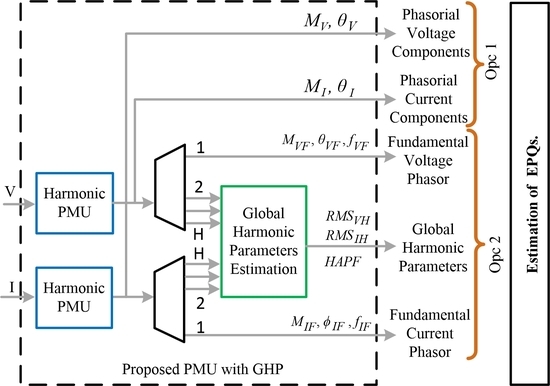Global Harmonic Parameters for Estimation of Power Quality Indices: An Approach for PMUs
Abstract
1. Introduction
2. Theoretical Background
2.1. Fundamental Phasor Estimation Model
2.2. Power Quality Index
3. HPMU and GHPs
4. Validation and Results
4.1. Study Case 1: Evaluation of PQIs
4.2. Study Case 2: Synthetic Signals
4.3. Study Case 3: Real Signals
5. Conclusions
Funding
Acknowledgments
Conflicts of Interest
Appendix A
| Phasor Harmonic Components (Option 1: Magnitude and Phase of Each Harmonic for h = 1 to 50) | |||||
|---|---|---|---|---|---|
| Stage 1 | Stage 2 | Stage 3 | Stage 4 | Stage 5 | |
| Ideal, P-Class, M-Class EP-class, EM-class | Ideal, P-Class, M-Class EP-class, EM-class | Ideal, P-Class, M-Class EP-class, EM-class | Ideal, P-Class, M-Class EP-class, EM-class | Ideal, P-Class, M-Class EP-class, EM-class | |
| Mv1 | 127.0, 127.000, 127.001, 4.3 × 10−6, 8.0 × 10−4 | 127.0, 127.000, 127.001, 1.8 × 10−9, 8.0 × 10−4 | 127.0, 127.000, 127.001, 8.7 × 10−11, 8.0 × 10−4 | 127.0, 127.000, 127.001, 6.3 × 10−12, 8.0 × 10−4 | 127.0, 126.989, 127.001, 8.9 × 10−3, 5.2 × 10−4 |
| Mv2 | 10.0, 10.000, 10.001, 2.9 × 10−4, 1.3 × 10−2 | 10.0, 10.000, 10.001, 1.7 × 10−7, 1.3 × 10−2 | 10.0, 10.000, 10.001, 8.4 × 10−9, 1.3 × 10−2 | 10.0, 10.000, 10.001, 6.5 × 10−10, 1.3 × 10−2 | 10.0, 9.908, 10.009, 9.2 × 10−1, 8.7 × 10−2 |
| Mv3 | 8.0, 8.000, 7.999, 9.6 × 10−4, 8.1 × 10−3 | 8.0, 8.000, 7.999, 7.3 × 10−7, 9.0 × 10−3 | 8.0, 8.000, 7.999, 3.6 × 10−8, 9.0 × 10−3 | 8.0, 8.000, 7.999, 1.8 × 10−9, 9.0 × 10−3 | 8.0, 8.085, 8.000, 1.1, 2.4 × 10−3 |
| Mv5 | 6.0, 6.000, 6.000, 7.8 × 10−4, 2.5 × 10−6 | 6.0, 6.000, 6.000, 5.2 × 10−7, 1.4 × 10−6 | 6.0, 6.000, 6.000, 2.5 × 10−8, 1.4 × 10−6 | 6.0, 6.000, 6.000, 1.3 × 10−9, 1.4 × 10−6 | 6.0, 5.912, 6.000, 1.5, 2.1 × 10−3 |
| Mv40 | 4.0, 4.000, 4.000, 2.4 × 10−5, 1.5 × 10−4 | 4.0, 4.000, 4.000, 1.1 × 10−9, 6.1 × 10−7 | 4.0, 4.000, 4.000, 1.0 × 10−10, 6.1 × 10−7 | 4.0, 4.000, 4.000, 1.7 × 10−10, 6.1 × 10−7 | 4.0, 4.000, 4.000, 3.9 × 10−3, 5.8 × 10−3 |
| Fv1 | 5.0, 5.000, 5.000, 4.3 × 10−3, 2.5 × 10−3 | 5.0, 5.000, 5.000, 2.1 × 10−6, 5.3 × 10−4 | 5.0, 5.000, 5.000, 1.0 × 10−7, 5.3 × 10−4 | 5.0, 5.000, 5.000, 4.9 × 10−9, 5.3 × 10−4 | 139.91, 139.880, 139.91, 2.1 × 10−2, 3.1 × 10−4 |
| Fv2 | 30.0, 30.001, 29.997, 3.0 × 10−3, 8.6 × 10−3 | 30.0, 30.000, 29.997, 7.6 × 10−7, 9.0 × 10−3 | 30.0, 30.000, 29.997, 3.9 × 10−8, 9.0 × 10−3 | 30.0, 30.000, 29.997, 1.8 × 10−9, 9.0 × 10−3 | 299.82, 300.024, 299.84, 6.8 × 10−2, 6.2 × 10−3 |
| Fv3 | 45.0, 45.001, 45.004, 1.2 × 10−3, 9.8 × 10−3 | 45.0, 45.000, 45.004, 1.2 × 10−6, 8.8 × 10−3 | 45.0, 45.000, 45.004, 5.8 × 10−8, 8.8 × 10−3 | 45.0, 45.000, 45.004, 2.8 × 10−9, 8.8 × 10−3 | 89.73, 89.859, 89.726, 1.4 × 10−1, 4.6 × 10−3 |
| Fv5 | 315.0, 314.999, 314.998, 2.8 × 10−4, 5.3 × 10−4 | 315.0, 315.000, 314.999, 1.2 × 10−7, 4.3 × 10−4 | 315.0, 315.000, 314.999, 5.9 × 10−9, 4.3 × 10−4 | 315.0, 315.000, 314.999, 2.8 × 10−10, 4.3 × 10−4 | 269.55, 269.265, 269.547, 1.1 × 10−1, 1.2 × 10−3 |
| Fv40 | 115.0, 114.992, 114.999, 7.2 × 10−3, 2.0 × 10−3 | 115.0, 115.000, 115.000, 4.5 × 10−6, 1.3 × 10−6 | 115.0, 115.000, 115.000, 4.0 × 10−8, 7.9 × 10−8 | 115.0, 115.000, 115.000, 1.4 × 10−9, 6.5 × 10−8 | 111.4, 111.413, 111.376, 1.2 × 10−2, 2.2 × 10−2 |
| Mi1 | 25.0, 25.000, 25.000, 3.6 × 10−5, 4.4 × 10−4 | 25.0, 25.000, 25.000, 1.6 × 10−8, 7.0 × 10−4 | 60.0, 60.000, 60.000, 1.1 × 10−9, 5.6 × 10−4 | 60.0, 60.000, 60.000, 6.3 × 10−11, 1.8 × 10−4 | 60.0, 59.964, 60.001, 6.0 × 10−2, 1.1 × 10−3 |
| Mi2 | 0.0, 0.000, 0.000, 4.5 × 10−5, 2.5 × 10−4 | 15.0, 15.000, 15.000, 2.3 × 10−8, 2.4 × 10−3 | 15.0, 15.000, 15.001, 3.5 × 10−9, 4.7 × 10−3 | 15.0, 15.000, 15.001, 2.7 × 10−10, 4.3 × 10−3 | 15.0, 14.998, 15.002, 1.0 × 10−2, 1.4 × 10−2 |
| Mi3 | 0.0, 0.000, 0.000, 3.3 × 10−5, 1.9 × 10−4 | 12.5, 12.500, 12.500, 4.7 × 10−8, 2.2 × 10−4 | 12.5, 12.500, 12.500, 8.4 × 10−9, 2.2 × 10−3 | 12.5, 12.500, 12.500, 6.3 × 10−10, 1.9 × 10−3 | 12.5, 12.485, 12.501, 1.2 × 10−1, 7.1 × 10−3 |
| Mi5 | 0.0, 0.000, 0.000, 6.6 × 10−6, 1.0 × 10−5 | 10.0, 10.000, 10.000, 3.5 × 10−7, 5.6 × 10−4 | 10.0, 10.000, 10.000, 2.0 × 10−8, 5.8 × 10−4 | 10.0, 10.000, 10.000, 8.8 × 10−10, 5.6 × 10−4 | 10.0, 10.000, 10.000, 2.0 × 10−3, 1.6 × 10−3 |
| Mi40 | 0.0, 0.000, 0.000, 2.6 × 10−6, 7.0 × 10−6 | 7.5, 7.500, 7.500, 1.5 × 10−8, 2.2 × 10−7 | 7.5, 7.500, 7.500, 3.3 × 10−10, 2.2 × 10−7 | 7.5, 7.500, 7.500, 2.9 × 10−11, 1.2 × 10−7 | 7.5, 7.500, 7.501, 4.2 × 10−3, 6.1 × 10−3 |
| Fi1 | 30.0, 30.000, 30.000, 7.0 × 10−4, 1.5 × 10−3 | 30.0, 30.000, 30.000, 2.7 × 10−7, 1.3 × 10−3 | 30.0, 30.000, 30.000, 1.5 × 10−8, 1.2 × 10−3 | 45.0, 45.000, 45.000, 4.4 × 10−10, 1.0 × 10−3 | 179.91, 179.918, 179.909, 4.6 × 10−3, 8.1 × 10−4 |
| Fi2 | 0.0, 141.850, 26.827, 141.850, 26.827 | 25.0, 25.000, 25.000, 3.9 × 10−7, 7.9 × 10−5 | 25.0, 25.000, 25.000, 5.5 × 10−9, 1.5 × 10−4 | 25.0, 25.000, 25.000, 3.3 × 10−10, 1.5 × 10−3 | 294.82, 294.807, 294.832, 4.4 × 10−3, 3.9 × 10−3 |
| Fi3 | 0.0, 136.730, 210.995, 136.730, 210.995 | 20.0, 20.000, 20.000, 5.8 × 10−7, 7.4 × 10−4 | 20.0, 20.000, 20.000, 5.7 × 10−9, 1.2 × 10−3 | 20.0, 20.000, 19.999, 8.7 × 10−11, 3.7 × 10−3 | 64.73, 64.714, 64.731, 2.5 × 10−2, 8.7 × 10−4 |
| Fi5 | 0.0, 135.180, 168.677, 135.180, 168.677 | 270.0, 270.000, 269.999, 1.8 × 10−7, 3.8 × 10−4 | 270.0, 270.000, 269.999, 9.5 × 10−9, 4.1 × 10−4 | 270.0, 270.000, 269.999, 4.8 × 10−10, 4.0 × 10−4 | 224.55, 224.586, 224.548, 1.6 × 10−2, 1.0 × 10−3 |
| Fi40 | 0.0, 174.440, 49.656, 174.440, 49.656 | 0.0, 0.000, 0.001, 5.4 × 10−7, 6.4 × 10−4 | 0.0, 0.000, 0.001, 2.7 × 10−8, 6.9 × 10−4 | 0.0, 0.000, 0.001, 1.4 × 10−9, 7.1 × 10−4 | 356.4, 356.418, 356.3797, 5.0 × 10−3, 5.7 × 10−3 |
| frec | 60.0, 59.999, 59.999, 1.0 × 10−3, 1.0 × 10−3 | 60.0, 60.000, 60.000, 9.6 × 10−7, 9.6 × 10−7 | 60.0, 60.000, 60.000, 4.7 × 10−8, 4.7 × 10−8 | 60.0, 60.000, 60.000, 2.2 × 10−9, 2.2 × 10−9 | 61.50, 61.502, 61.502, 3.4 × 10−3, 3.4 × 10−3 |
| Global harmonic parameters (Option 2: GHP with fundamental parameters Mv1, Mi1, Fv1 and Fi1) | |||||
| RMSHV | 14.697, 14.697, 14.697, 3.3 × 10−4, 3.8 × 10−3 | 14.697, 14.697, 14.697, 2.3 × 10−7, 3.4 × 10−3 | 14.697, 14.697, 14.697, 1.1 × 10−8, 3.4 × 10−3 | 14.697, 14.697, 14.697, 6.8 × 10−10, 3.4 × 10−3 | 14.697, 14.629, 14.703, 4.6 × 10−1, 4.1 × 10−2 |
| RMSHI | 0.0, 0.000, 0.000, 5.7 × 10−5, 3.2 × 10−4 | 23.184, 23.184, 23.184, 5.9 × 10−8, 1.0 × 10−3 | 23.184, 23.184, 23.184, 6.1 × 10−9, 1.4 × 10−3 | 23.184, 23.184, 23.184, 4.0 × 10−10, 1.4 × 10−3 | 23.184, 23.175, 23.186, 3.8 × 10−2, 8.3 × 10−3 |
| HAPF | 0.0, −0.250, 0.198, 2.5 × 10−1, 2.0 × 10−1 | 0.792, 0.792, 0.792, 2.2 × 10−7, 4.3 × 10−4 | 0.792, 0.792, 0.792, 9.5 × 10−9, 5.2 × 10−4 | 0.792, 0.792, 0.792, 5.3 × 10−10, 4.0 × 10−4 | 0.792, 0.792, 0.792, 3.9 × 10−2, 1.1 × 10−2 |
| PQIs for Both Option | |||||
|---|---|---|---|---|---|
| Stage 1 | Stage 2 | Stage 3 | Stage 4 | Stage 5 | |
| Ideal, P-Class, M-Class EP-class, EM-class | Ideal, P-Class, M-Class EP-class, EM-class | Ideal, P-Class, M-Class EP-class, EM-class | Ideal, P-Class, M-Class EP-class, EM-class | Ideal, P-Class, M-Class EP-class, EM-class | |
| RMSV | 127.848, 127.848, 127.849, 6.5 × 10−8, 8.4 × 10−4 | 127.848, 127.848, 127.849, 1.3 × 10−9, 8.4 × 10−4 | 127.848, 127.848, 127.849, 6.5 × 10−11, 8.4 × 10−4 | 127.848, 127.848, 127.849, 3.1 × 10−12, 8.4 × 10−4 | 127.848, 127.828, 127.849, 1.5 × 10−2, 1.1 × 10−3 |
| RMSI | 25.0, 25.000, 25.000, 3.6 × 10−5, 4.4 × 10−4 | 34.095, 34.095, 34.096, 3.6 × 10−8, 8.6 × 10−4 | 64.323, 64.323, 64.324, 1.7 × 10−9, 6.8 × 10−4 | 64.323, 64.323, 64.324, 1.1 × 10−10, 3.4 × 10−4 | 64.323, 64.287, 64.325, 5.7 × 10−2, 2.1 × 10−3 |
| THDV | 11.572, 11.572, 11.573, 3.3 × 10−4, 3.0 × 10−3 | 11.572, 11.572, 11.573, 2.3 × 10−7, 2.6 × 10−3 | 11.572, 11.572, 11.573, 1.2 × 10−8, 2.6 × 10−3 | 11.572, 11.572, 11.573, 6.8 × 10−10, 2.6 × 10−3 | 11.572, 11.520, 11.577, 4.6 × 10−1, 4.1 × 10−2 |
| THDI | 0.0, 0.000, 0.001, 2.3 × 10−4, 1.3 × 10−3 | 92.736, 92.736, 92.737, 4.3 × 10−8, 3.5 × 10−4 | 38.640, 38.640, 38.640, 5.1 × 10−9, 8.7 × 10−4 | 38.640, 38.640, 38.641, 3.3 × 10−10, 1.2 × 10−3 | 38.640, 38.649, 38.643, 2.2 × 10−2, 7.1 × 10−3 |
| ST | 3196.189, 3196.188, 3196.230, 3.6 × 10−5, 1.3 × 10−3 | 4359.021, 4359.021, 4359.095, 3.4 × 10−8, 1.7 × 10−3 | 8223.590, 8223.590, 8223.715, 1.6 × 10−9, 1.5 × 10−3 | 8223.590, 8223.590, 8223.687, 1.0 × 10−10, 1.2 × 10−3 | 8223.590, 8217.705, 8223.846, 7.2 × 10−2, 3.1 × 10−3 |
| PF | 2877.527, 2877.526, 2877.570, 4.4 × 10−5, 1.5 × 10−3 | 2877.527, 2877.527, 2877.579, 3.5 × 10−8, 1.8 × 10−3 | 6906.065, 6906.065, 6906.179, 1.6 × 10−9, 1.6 × 10−3 | 5837.259, 5837.259, 5837.354, 1.4 × 10−10, 1.6 × 10−3 | 5837.259, 5830.016, 5837.442, 1.2 × 10−1, 3.1 × 10−3 |
| QF | −1341.813, −1341.813, −1341.814, −2.2 × 10−5, −4.5 × 10−5 | −1341.813, −1341.813, −1341.815, −6.4 × 10−8, −1.5 × 10−4 | −3220.351, −3220.351, −3220.354, −1.0 × 10−9, −9.6 × 10−5 | −4898.042, −4898.042, −4898.045, −2.8 × 10−11, −7.3 × 10−5 | −4898.042, −4898.561, −4898.019, −1.1 × 10−2, −4.6 × 10−4 |
| SF | 3175, 3174.999, 3175.039, 4.0 × 10−5, 1.2 × 10−3 | 3175.0, 3175.000, 3175.048, 1.8 × 10−8, 1.5 × 10−3 | 7620.0, 7620.000, 7620.104, 1.1 × 10−9, 1.4 × 10−3 | 7620.0, 7620.000, 7620.075, 6.9 × 10−11, 9.9 × 10−4 | 7620.0, 7614.787, 7620.126, 6.8 × 10−2, 1.6 × 10−3 |
| SN | 367.423, 367.425, 367.439, 2.9 × 10−4, 4.2 × 10−3 | 2986.710, 2986.710, 2986.767, 5.3 × 10−8, 1.9 × 10−3 | 3092.416, 3092.416, 3092.491, 4.7 × 10−9, 2.4 × 10−3 | 3092.416, 3092.416, 3092.488, 3.1 × 10−10, 2.3 × 10−3 | 3092.416, 3089.610, 3092.787, 9.1 × 10−2, 1.2 × 10−2 |
| DI | 0.0, 0.007, 0.040, 7.2 × 10−3, 4.0 × 10−2 | 2944.374, 2944.374, 2944.428, 6.1 × 10−8, 1.8 × 10−3 | 2944.374, 2944.374, 2944.440, 6.2 × 10−9, 2.2 × 10−3 | 2944.374, 2944.374, 2944.438, 4.0 × 10−9, 2.2 × 10−3 | 2944.374, 2943.005, 2944.633, 4.6 × 10−2, 8.8 × 10−3 |
| DV | 367.423, 367.425, 367.439, 2.9 × 10−4, 4.2 × 10−3 | 367.423, 367.423, 367.439, 2.2 × 10−7, 4.1 × 10−3 | 881.816, 881.816, 881.852, 1.0 × 10−8, 4.0 × 10−3 | 881.816, 881.816, 881.848, 6.2 × 10−10, 3.6 × 10−3 | 881.816, 877.196, 882.189, 5.2 × 10−1, 4.2 × 10−2 |
| SH | 0.0, 0.001, 0.005, 8.3 × 10−4, 4.7 × 10−3 | 340.735, 340.735, 340.750, 1.7 × 10−7, 4.5 × 10−3 | 340.735, 340.735, 340.751, 5.3 × 10−9, 4.9 × 10−3 | 340.735, 340.735, 340.751, 2.9 × 10−10, 4.8 × 10−3 | 340.735, 339.024, 340.903, 5.0 × 10−1, 4.9 × 10−2 |
| PH | 0.0, 0.000, 0.001, 2.1 × 10−4, 9.2 × 10−4 | 269.808, 269.808, 269.821, 4.9 × 10−8, 4.9 × 10−3 | 269.808, 269.808, 269.822, 4.1 × 10−9, 5.4 × 10−3 | 269.808, 269.808, 269.822, 2.4 × 10−10, 5.2 × 10−3 | 269.808, 268.558, 269.971, 4.6 × 10−1, 6.1 × 10−2 |
| DH | 0.0, 0.001, 0.005, 8.1 × 10−4, 4.6 × 10−3 | 208.095, 208.095, 208.103, 5.5 × 10−7, 3.8 × 10−3 | 208.095, 208.095, 208.104, 2.1 × 10−8, 4.0 × 10−3 | 208.095, 208.095, 208.104, 1.2 × 10−9, 4.1 × 10−3 | 208.095, 206.914, 208.159, 5.7 × 10−1, 3.0 × 10−2 |
| P | 2877.527, 2877.526, 2877.571, 5.1 × 10−5, 1.5 × 10−3 | 3147.335, 3147.335, 3147.400, 3.6 × 10−8, 2.1 × 10−3 | 7175.873, 7175.873, 7176.001, 1.7 × 10−9, 1.8 × 10−3 | 6107.066, 6107.066, 6107.176, 1.4 × 10−10, 1.8 × 10−3 | 6107.066, 6098.574, 6107.413, 1.4 × 10−1, 5.7 × 10−3 |
| N | 1391.209, 1391.209, 1391.212, 3.1 × 10−5, 2.0 × 10−4 | 3015.849, 3015.849, 3015.888, 3.2 × 10−8, 1.3 × 10−3 | 4016.750, 4016.750, 4016.776, 1.5 × 10−9, 6.5 × 10−4 | 5507.375, 5507.375, 5507.398, 5.5 × 10−11, 4.2 × 10−4 | 5507.375, 5508.001, 5507.373, 1.1 × 10−2, 3.2 × 10−5 |
| PF1 | 0.906, 0.906, 0.906, 3.9 × 10−6, 2.6 × 10−4 | 0.906, 0.906, 0.906, 1.8 × 10−8, 2.9 × 10−4 | 0.906, 0.906, 0.906, 4.7 × 10−10, 2.8 × 10−4 | 0.766, 0.766, 0.766, 6.8 × 10−11, 6.4 × 10−4 | 0.766, 0.766, 0.766, 5.6 × 10−2, 1.5 × 10−3 |
| PF | 0.900, 0.900, 0.900, 1.6 × 10−5, 2.5 × 10−4 | 0.722, 0.722, 0.722, 1.9 × 10−9, 3.7 × 10−4 | 0.873, 0.873, 0.873, 5.8 × 10−11, 2.7 × 10−4 | 0.743, 0.743, 0.743, 3.9 × 10−11, 6.1 × 10−4 | 0.743, 0.742, 0.743, 6.8 × 10−2, 2.6 × 10−3 |
References
- de La Ree, J.; Centeno, V.; Thorp, J.S.; Phadke, A.G. Synchronized phasor measurement applications in power systems. IEEE Trans. Smart Grid 2010, 1, 20–27. [Google Scholar] [CrossRef]
- Hojabri, M.; Dersch, U.; Papaemmanouil, A.; Bosshart, P. A Comprehensive Survey on Phasor Measurement Unit Applications in Distribution Systems. Energies 2019, 12, 4552. [Google Scholar] [CrossRef]
- Phadke, A.G.; Thorp, J.S. Synchronized Phasor Measurements and their Applications; Springer: New York, NY, USA, 2008; ISBN 978-0-387-76535-8. [Google Scholar]
- Power, I.; Society, E. C37.118.1-2011—IEEE Standard for Synchrophasor Measurements for Power Systems; IEEE: Piscataway, NJ, USA, 2011. [Google Scholar]
- Carta, A.; Locci, N.; Muscas, C. GPS-based system for the measurement of synchronized harmonic phasors. IEEE Trans. Instrum. Meas. 2009, 58, 586–593. [Google Scholar] [CrossRef]
- Al-Shetwi, A.Q.; Hannan, M.A.; Jern, K.P.; Alkahtani, A.A.; PG Abas, A.E. Power Quality Assessment of Grid-Connected PV System in Compliance with the Recent Integration Requirements. Electronics 2020, 9, 366. [Google Scholar] [CrossRef]
- Tian, M.; Wang, Y.; Li, J. Comprehensive Harmonic Responsibility Calculation Based on Different Weighting Methods. Energies 2019, 12, 4449. [Google Scholar] [CrossRef]
- Oureilidis, K.; Malamaki, K.-N.; Gallos, K.; Tsitsimelis, A.; Dikaiakos, C.; Gkavanoudis, S.; Cvetkovic, M.; Mauricio, J.M.; Maza Ortega, J.M.; Ramos, J.L.M.; et al. Ancillary Services Market Design in Distribution Networks: Review and Identification of Barriers. Energies 2020, 13, 917. [Google Scholar] [CrossRef]
- Bernabeu, E.E. Single-phase transformer harmonics produced during geomagnetic disturbances: Theory, modeling, and monitoring. IEEE Trans. Power Deliv. 2015, 30, 1323–1330. [Google Scholar] [CrossRef]
- Dash, P.K.; Padhee, M.; Barik, S.K. Estimation of power quality indices in distributed generation systems during power islanding conditions. Int. J. Electr. Power Energy Syst. 2012, 36, 18–30. [Google Scholar] [CrossRef]
- Ukai, H.; Nakamura, K.; Matsui, N. DSP- and GPS-Based Synchronized Measurement System of Harmonics in Wide-Area Distribution System. IEEE Trans. Ind. Electron. 2003, 50, 1159–1164. [Google Scholar] [CrossRef]
- Carta, A.; Locci, N.; Muscas, C. A PMU for the measurement of synchronized harmonic phasors in three-phase distribution networks. IEEE Trans. Instrum. Meas. 2009, 58, 3723–3730. [Google Scholar] [CrossRef]
- Chen, C.I. A phasor estimator for synchronization between power grid and distributed generation system. IEEE Trans. Ind. Electron. 2013, 60, 3248–3255. [Google Scholar] [CrossRef]
- Chakir, M.; Kamwa, I.; Le Huy, H. Extended C37.118.1 PMU algorithms for joint tracking of fundamental and harmonic phasors in stressed power systems and microgrids. IEEE Trans. Power Deliv. 2014, 29, 1465–1480. [Google Scholar] [CrossRef]
- Gungor, V.C.; Sahin, D.; Kocak, T.; Ergut, S.; Buccella, C.; Cecati, C.; Hancke, G.P. A Survey on smart grid potential applications and communication requirements. IEEE Trans. Ind. Inform. 2013, 9, 28–42. [Google Scholar] [CrossRef]
- Gadde, P.H.; Biswal, M.; Brahma, S.; Cao, H. Efficient Compression of PMU Data in WAMS. IEEE Trans. Smart Grid 2016, 7, 2406–2413. [Google Scholar] [CrossRef]
- Fu, L.; Zhu, T.; Pan, G.; Chen, S.; Zhong, Q.; Wei, Y. Power Quality Disturbance Recognition Using VMD-Based Feature Extraction and Heuristic Feature Selection. Appl. Sci. 2019, 9, 4901. [Google Scholar] [CrossRef]
- Valtierra-Rodriguez, M.; Romero-Troncoso, R.D.J.; Garcia-Perez, A.; Granados-Lieberman, D.; Osornio-Rios, R.A. Reconfigurable instrument for neural-networkbased power-quality monitoring in 3-phase power systems. IET Gener. Transm. Distrib. 2013, 7, 1498–1507. [Google Scholar] [CrossRef]
- 1459-2010 IEEE Standard Definitions for the Measurement of Electric Power Quantities Under Sinusoidal, Nonsinusoidal, Balanced, or Unbalanced Conditions; IEEE: Piscataway, NJ, USA, 2010.
- Caramia, P.; Carpinelli, G.; Verde, P. Power Quality Indices in Liberalized Markets; Wiley: Chichester, UK, 2009; ISBN 9780470033951. [Google Scholar]
- 519-2014 IEEE Recommended Practice and Requirements for Harmonic Control in Electric Power Systems; IEEE: Piscataway, NJ, USA, 2014.
- IEC 61000-4-7:2002|IEC Webstore|Electromagnetic Compatibility, EMC, Smart City. Available online: https://webstore.iec.ch/publication/4226 (accessed on 20 January 2020).
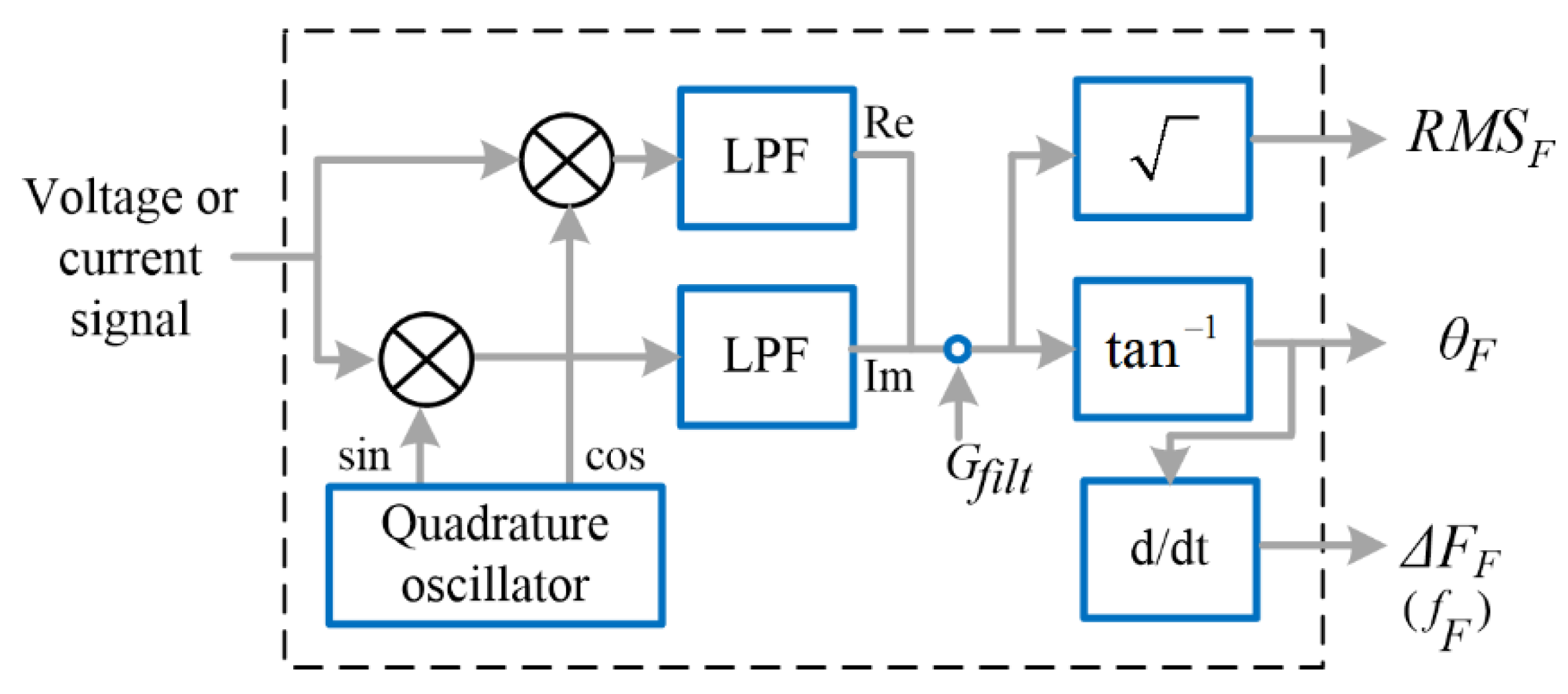
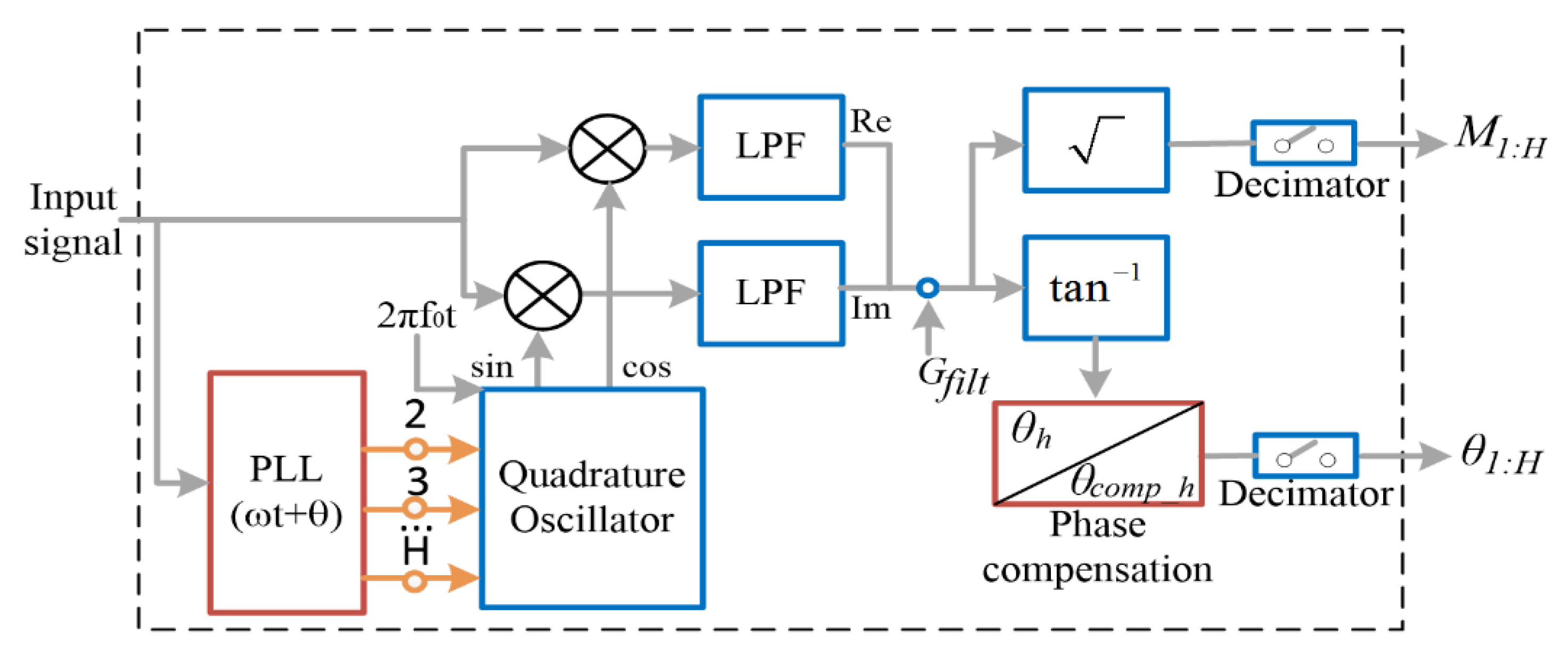
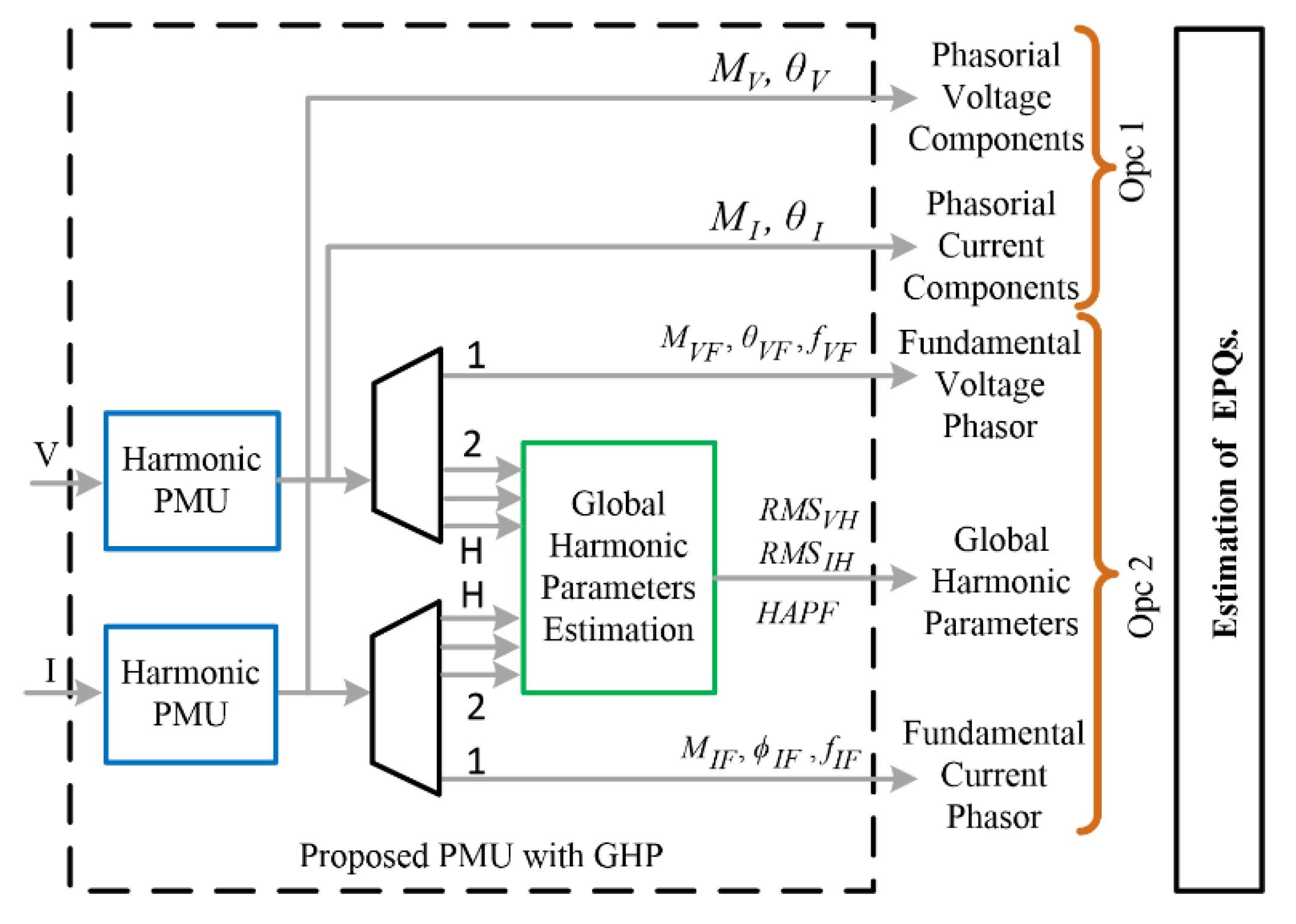
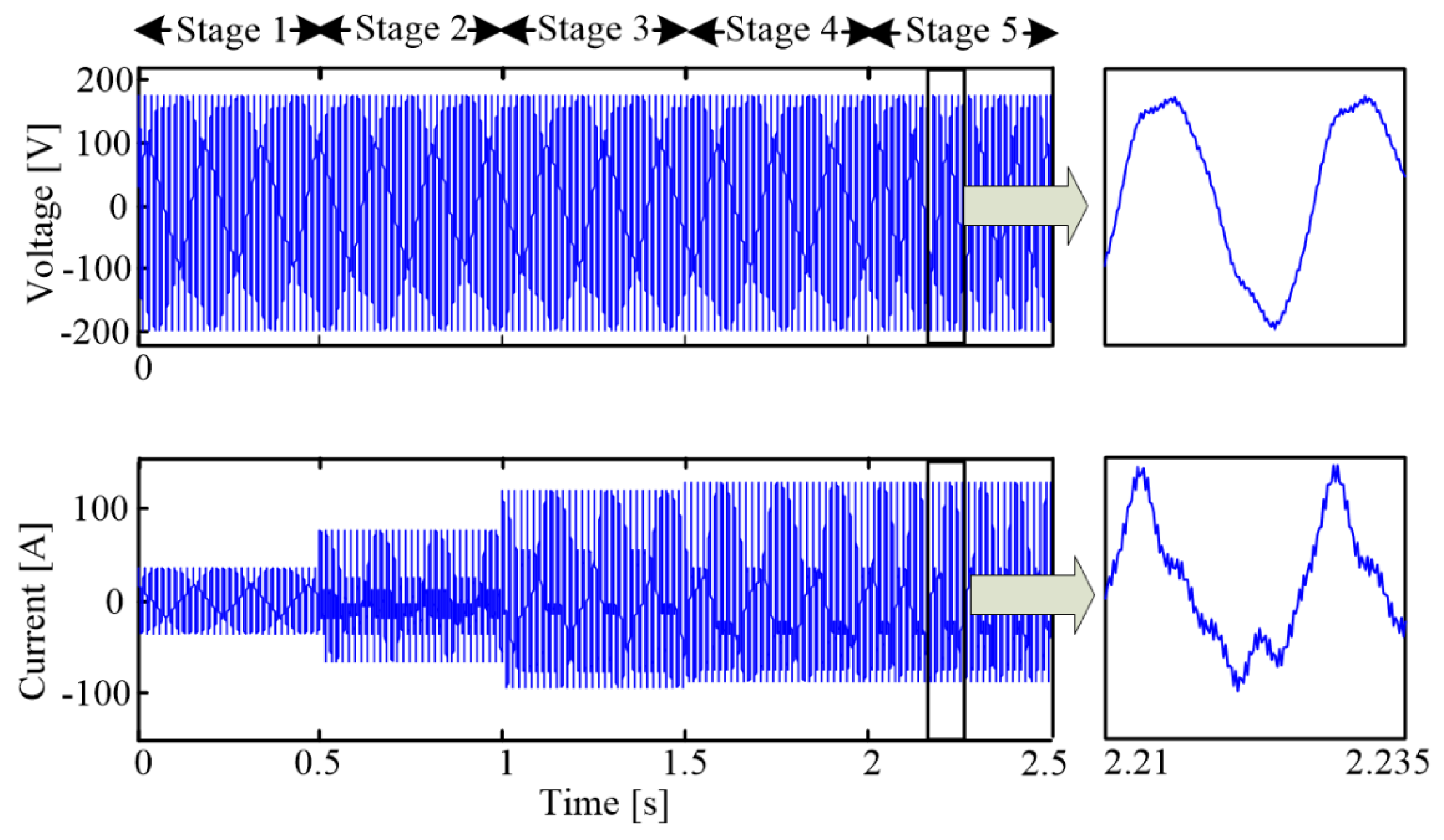
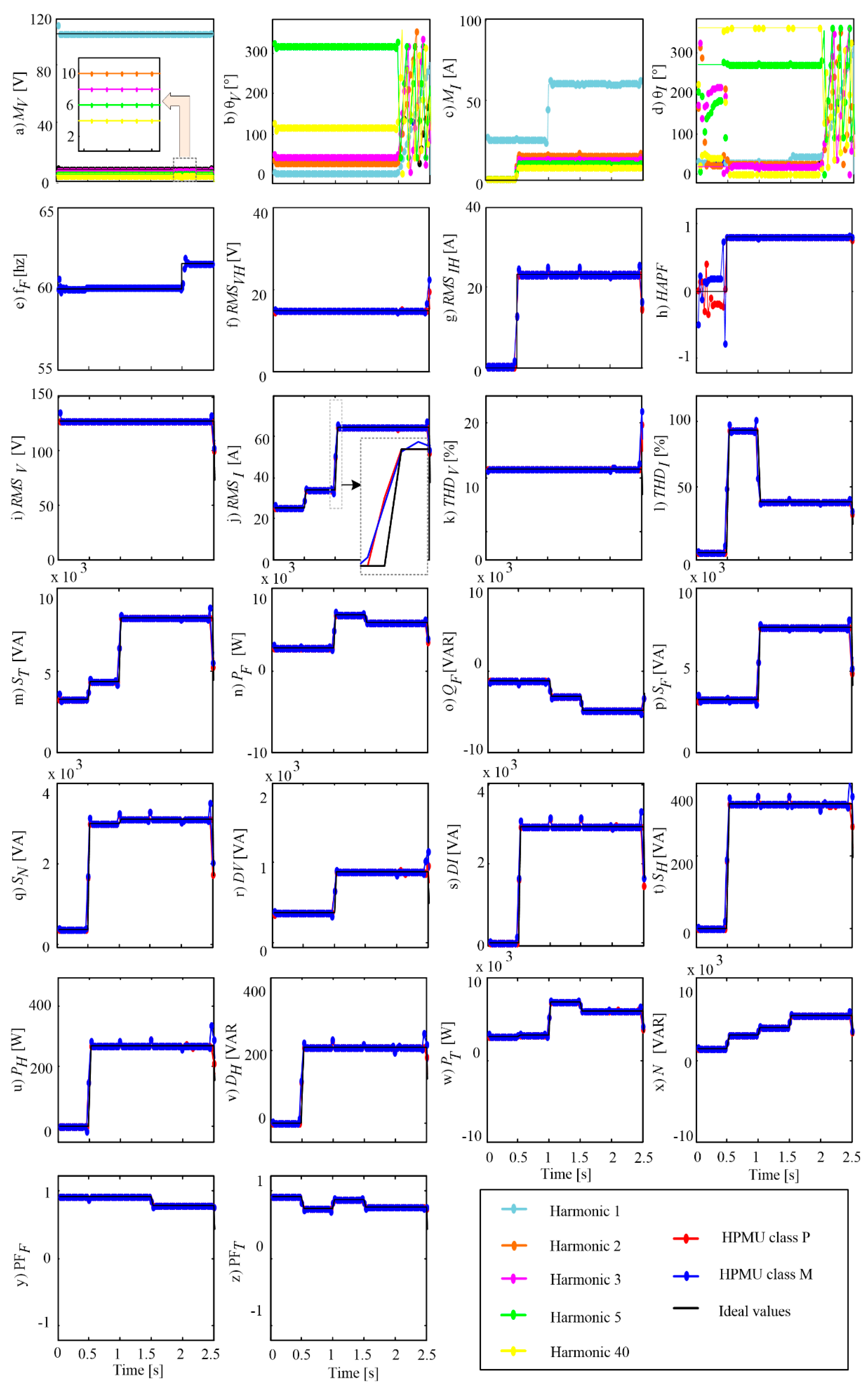

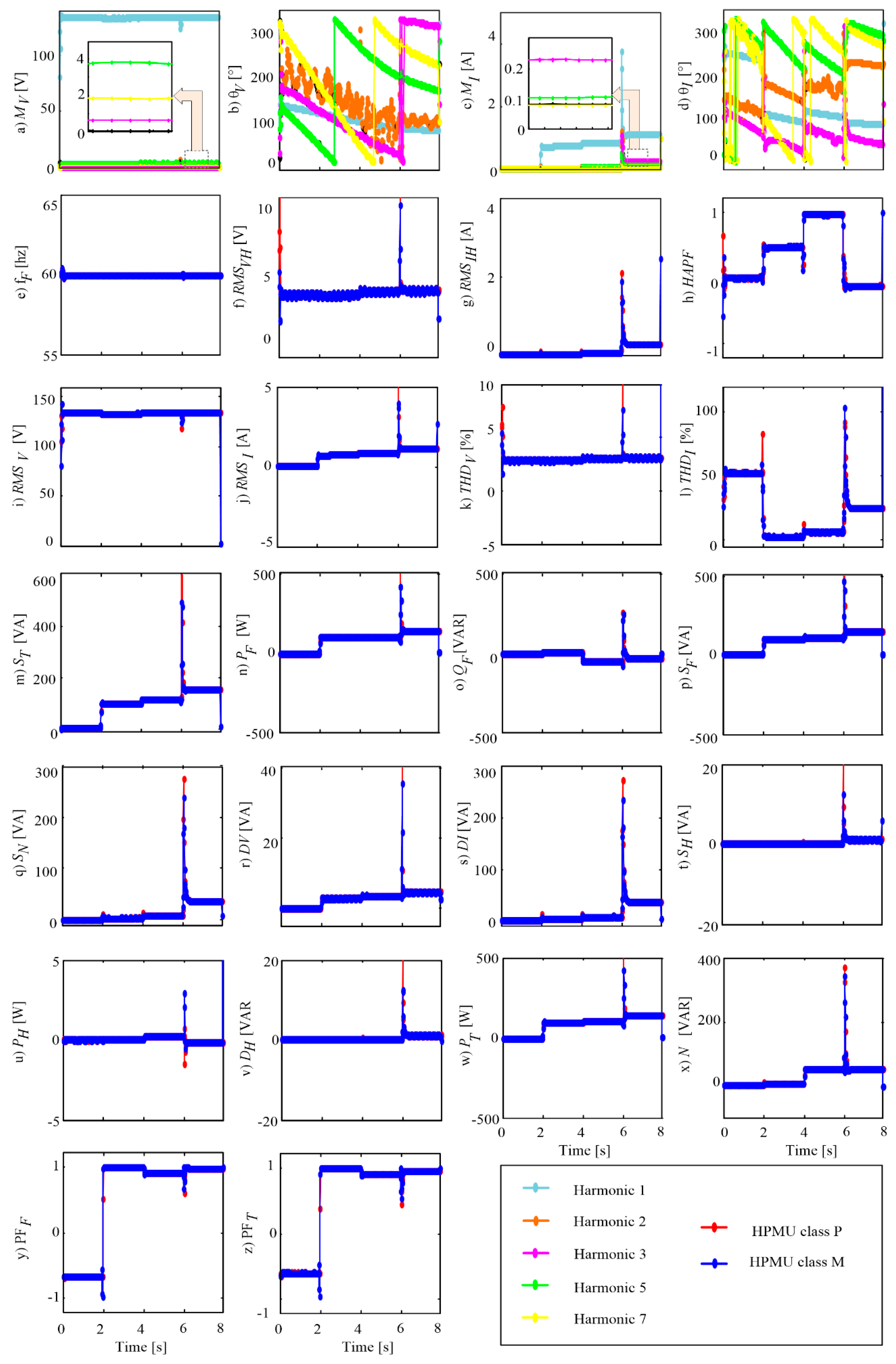
| Classical Formulation | GHPs-Based Formulation |
|---|---|
| True RMS value of Voltage (RMSV) and Current (RMSI) | |
| Total Harmonic Distortion of Voltage (THDV) and Current (THDI) | |
| Total Apparent Power (ST) | |
| Fundamental Real Power (PF) | |
| Fundamental Active Power (QF) | |
| Fundamental Apparent Power (SF) | |
| Non-60 Hz or Nonfundamental Apparent Power (SN) | |
| Current Distortion Power (DI) | |
| Voltage Distortion Power (DV) | |
| Harmonic Apparent Power (SH) | |
| Harmonic Real Power (PH) | |
| Harmonic Distortion Power (DH) | |
| Active Power Total (PT) | |
| Non Active Power (N) | |
| Power Factor (PFF) | |
| Total Power Factor (PFT) | |
| Voltage Components | Current Components | ||
|---|---|---|---|
| V1 /θ1 | √2·100 V/0° | I1 /φ1 | √2·100 A/30° |
| V3 /θ3 | √2·8 V/−70° | I3 /φ3 | √2·20 A/165° |
| V5 /θ5 | √2·15 V/140° | I5 /φ5 | √2·15 A/233° |
| V7 /θ7 | √2·5 V/20° | I7 /φ7 | √2·10 A/−72° |
| PQI | Option 1 | Option 2 | PQI | Option 1 | Option 2 |
|---|---|---|---|---|---|
| RMSV | 101.56 V | 101.56 V | DI | 2692.6 VAR | 2692.6 VAR |
| RMSI | 103.56 A | 103.56 A | DV | 1772.0 VAR | 1772.0 VAR |
| THDV | 17.72 % | 17.72 % | SH | 477.13 VA | 477.13 VA |
| THDI | 26.93 % | 26.93 % | PH | −27.47 W | −27.47 W |
| ST | 10517.5 VA | 10517.5 VA | DH | 476.34 VAR | 476.34 VAR |
| PF | 8660.3 W | 8660.3 W | PT | 8632.8 W | 8632.8 W |
| QF | 5000 VAR | 5000 VAR | N | 6007.7 VAR | 6007.7 VAR |
| SF | 10000 VA | 10000 VA | PFF | 0.87 | 0.87 |
| SN | 3258.5 VA | 3258.5 VA | PFT | 0.82 | 0.82 |
| Stages for v(t) | f | V1/θ1 | V2/θ2 | V3/θ3 | V5/θ5 | V40/θ7 |
|---|---|---|---|---|---|---|
| 1,2,3,4 | 60 Hz | 127 V/5° | 10 V/30° | 8 V/45° | 6 V/−45° | 4 V/115° |
| 5 | 61.5 Hz | |||||
| Stages for i(t) | F | I1 /ϕ1 | I2 /ϕ2 | I3 /ϕ3 | I5 /ϕ5 | I40 /ϕ7 |
| 1 | 60 Hz | 25A/35° | 0 | |||
| 2 | 25A/35° | 15 A/25° | 12.5 A/20° | 10 A/−90° | 7.5 A/0° | |
| 3 | 60A/35° | |||||
| 4 | 60A/115° | |||||
| 5 | 61.5 Hz | 60A/115° | ||||
© 2020 by the author. Licensee MDPI, Basel, Switzerland. This article is an open access article distributed under the terms and conditions of the Creative Commons Attribution (CC BY) license (http://creativecommons.org/licenses/by/4.0/).
Share and Cite
Granados-Lieberman, D. Global Harmonic Parameters for Estimation of Power Quality Indices: An Approach for PMUs. Energies 2020, 13, 2337. https://doi.org/10.3390/en13092337
Granados-Lieberman D. Global Harmonic Parameters for Estimation of Power Quality Indices: An Approach for PMUs. Energies. 2020; 13(9):2337. https://doi.org/10.3390/en13092337
Chicago/Turabian StyleGranados-Lieberman, David. 2020. "Global Harmonic Parameters for Estimation of Power Quality Indices: An Approach for PMUs" Energies 13, no. 9: 2337. https://doi.org/10.3390/en13092337
APA StyleGranados-Lieberman, D. (2020). Global Harmonic Parameters for Estimation of Power Quality Indices: An Approach for PMUs. Energies, 13(9), 2337. https://doi.org/10.3390/en13092337




